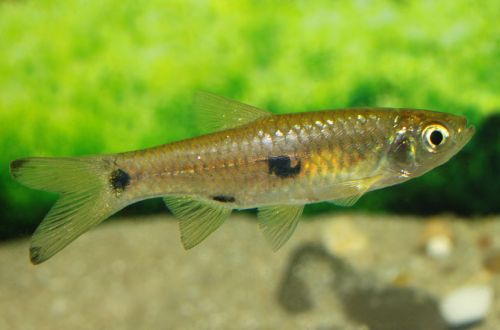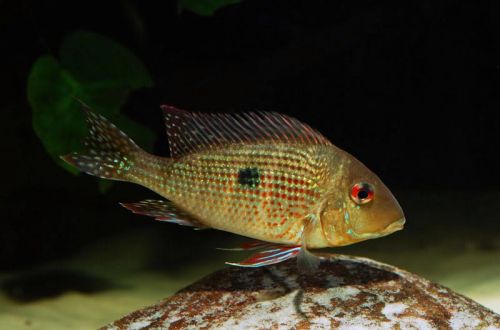
Glass Tetra
The glass tetra, scientific name Prionobrama filigera, belongs to the Characidae family. The main highlight of this species is an almost completely transparent body with a bright red tail. Another feature is its excellent adaptation to various water conditions and compatibility with many other tropical fish, making it a good candidate for the general aquarium.
Contents
Habitat
It is ubiquitous throughout the Amazon basin in the territory of the modern states of Ecuador, Colombia, Peru, Bolivia and Brazil. It lives near the surface in the upper layers of water, mainly in small streams, rivers and channels of larger rivers; it does not occur in the main channels.
Brief information:
- The volume of the aquarium – from 70 liters.
- Temperature – 23-27°C
- Value pH — 6.0–8.0
- Water hardness – soft to hard (2-30 dGH)
- Substrate type – any
- Lighting – subdued
- Brackish water – no
- Water movement is weak
- The size of the fish is up to 6 cm.
- Food – any food
- Temperament – peaceful
- Keeping in a flock of at least 6-10 individuals
Description
Adults reach a length of about 6 cm. They have an almost transparent body, through which the ridge and internal organs of the fish are clearly visible. The only colored area is the red tail. Sexual dimorphism is weakly expressed, it is possible to distinguish males from females by the elongated edge of the anal fin, somewhat resembling a spike.
Food
Feeds from the surface, feed only floating food. In a home aquarium, it will accept all types of dry, frozen and live food. The quality of the products directly affects the well-being and color of the fish, so use food exclusively from trusted well-known manufacturers.
Maintenance and care, arrangement of the aquarium
A group of fish of 6-8 individuals will require a tank of 70 liters or more. The design uses a large number of plants, but placed in such a way as to preserve significant areas of free space. Floating plants are also welcome and will provide cover if the Glass Tetra senses danger. The lower bottom layers do not have mandatory requirements and are designed at the discretion of the aquarist, for example, you can place a sandy substrate and install decorative elements (snags, sunken ships, castles, etc.).
The hydrochemical composition of water is within the wide allowable pH and dGH values. To simulate the water conditions typical of the natural habitat, it is recommended to add a few fallen leaves and / or cones of deciduous plants, oak bark to the bottom. Over time, the water will turn light brown as the tannins dissolve. The leaves are pre-dried, then soaked in containers until they sink, and only then placed in the aquarium. Leaves are updated once a couple of weeks, bumps once a month.
A similar effect can be achieved with less effort by using a cloth bag filled with peat and using a filter with peat-based filter material. It is worth noting that the peat for the bag is purchased exclusively at the pet store, where it is supplied after special processing.
Behavior and Compatibility
Peaceful, very active schooling species, content in a group of at least 6–8 individuals, with a smaller number, skirmishes arise between males in the struggle for dominance. Due to its excellent adaptation to various water conditions, the Glass Tetra can be combined with many other species of similar size and temperament. Should not be kept with surface dwelling fish such as Hatchetfish to avoid unnecessary competition for food and space.
Breeding / breeding
Refers to spawning species, parental instincts are weakly expressed, so eggs and fry can be eaten by adult fish. Breeding should be organized in a separate tank – a spawning aquarium. Usually they use a tank with a volume of about 20 liters, the design does not matter. In order to protect future offspring, the bottom is covered with a fine mesh or a layer of balls 1–2 cm in diameter, or dense thickets of low small-leaved plants or mosses are planted. Fill with water from the main aquarium just before placing the fish. The lighting is subdued, and a simple sponge airlift filter and heater are sufficient equipment.
Spawning is stimulated by the establishment of pH and dGH values at 6.0–6.5 and 1–5, respectively, at a temperature of about 25–26°C. In the diet, a significant proportion should be protein products (bloodworm, daphnia, brine shrimp, etc.). After some time, some fish will become significantly rounded – it is the females who will fill with caviar.
Females and the largest and brightest males are placed in a separate aquarium. At the end of spawning, the newly-minted parents are returned back. The fry appear after 14–36 hours, and already on the 3rd–4th day they begin to swim freely, from this moment they need food. Feed with special food for juvenile aquarium fish.
Fish diseases
A balanced aquarium biosystem with suitable conditions is the best guarantee against the occurrence of any diseases, therefore, if the fish has changed behavior, color, unusual spots and other symptoms appear, first check the water parameters, and only then proceed to treatment.





